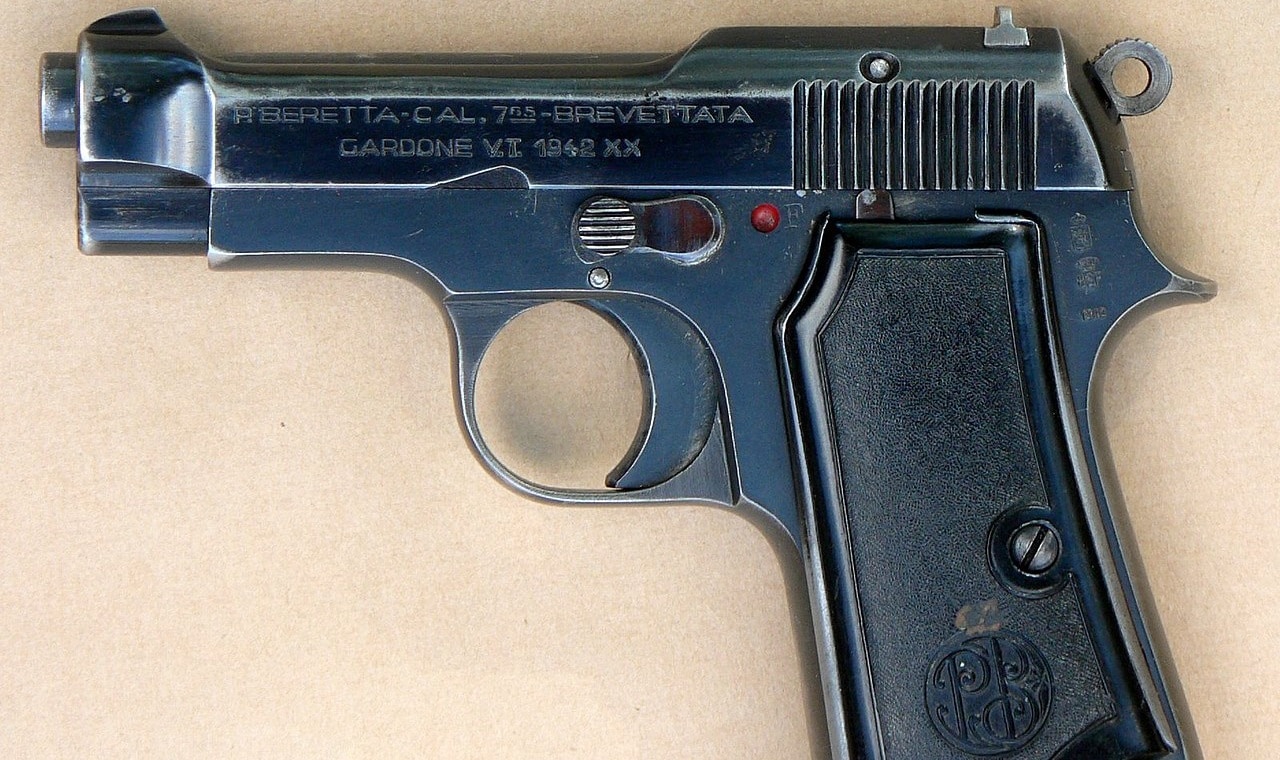As I have pointed out in multiple articles, Beretta — or more fully, Fabbrica d’Armi Pietro Beretta of Gardone Val Trompia, Italy — is not only the world’s oldest gunmaker, but indeed the world’s oldest existing industrial firm of any kind.
The company dates back to 1526, showing far more stability than its host country, which has gone through a mind-numbing 68 governments in 76 years.
In that 497-year span, Beretta has supplied firearms for all sorts of governments, from renaissance royalty to present NATO democracies.
Unfortunately, at one point one of those governments was Benito Mussolini’s Fascist Italy, which is akin to many highly reputable German firearms manufacturers having made firearms for Nazi Germany. This is not meant as a condemnation or indictment of any of those firms. It is a simple acknowledgement of historical reality.
With that in mind, we are going to take a look at one of the most significant handguns of Mussolini’s Italy: the Beretta M1935 semiauto pistol.
Beretta M1935 Early History and Specifications
As the alphanumeric designation suggests, the Beretta M1935 was designed in 1935. It was the immediate successor to the M1934, which goes to show that Beretta was never a company willing to rest on its laurels. Intended by the manufacturer as a competitor to the German Walther PP — the direct ancestor of the legendary Walther PPK — Beretta took the .380 ACP (9mm Corto) chambering of the M1934 and modified it to fire the .32 ACP (7.65mm) cartridge for the M1935. The Italian armed forces officially adopted the newer pistol in 1937.
It was a single-action direct blowback pistol. As noted by the website Historical Firearms, “The M1935 is arguably the smallest service semi-automatic pistol of the Second World War.” Specifications included a barrel length of 3.75 inches, overall length of 6 inches, a height of 5.12 inches, a width of 1.18 inches, and an empty weight of 23.5 ounces. Standard magazine capacity was 8+1 rounds.
Combat Performance
Approximately 525,000 of these pistols would be produced between 1935 and 1967. Per the Military Factory website, this “allowed the weapon to see combat service in World War 2 and beyond, for it proved itself a most reliable and high-quality weapon even under the most deplorable of circumstances (if adequately maintained). Issuance was initially to Italian Air Force and flight crews as a self-defense measure. It is noteworthy that the .32 ACP cartridge was considered rather light for military service, lowering the pistol’s effectiveness at range, and the weapon was further limited by its 8-round magazine capacity. Regardless, the sidearm was a high respected [sic] design and prized by local, allied, and enemy forces throughout World War 2.” The pistol also ended up being issued to naval officers and army tank crews.
Experts’ Shooting Impressions/Range Reports
Gun writer “Ahab,” on his Shall Not Be Questioned website, provides us with the following range report.
“At the range I had a box of Speer Gold Dots (20 rounds), and a box of good old Winchester white box (50). All shots were fired at seven yards, due to the rather rudimentary sights on the old gun…Once I figured out to just load 6 rounds, the gun ran fine on the WWB ammo. Group size at 7 yards isn’t really worth mentioning, however I was able to keep rapid fire strings in the A zone of an IDPA target. The only time the pistol failed to run properly was with the Gold Dots (which is too bad), as the hollowpoint nose would sometimes snag on the ramp. I could fix this if I wanted to carry the gun, but since I’m just going to use it for busting dirt clods on the farm, I’m not too worried.”
Interestingly, Ahab also states that the M1935 is the easiest firearm to field-strip that he has ever owned in his life. (I say the same thing about my beloved 9x18mm Makarov pistol, and I would rate my even more beloved Beretta M9 a close second.) “Drop the mag, lock the slide to the rear, pull the barrel out of the ‘Beretta’ slot in the slide, then unlock the slide and pull it off the front of the weapon. Done. I can literally take it apart and put it back together again in under 20 seconds, it’s that easy.”
Want Your Own?
Simpson Ltd. has two available, one at $895 and the other at $1,075 (the latter includes a leather flap holster and extra magazine). Guns.Com is listing one at $699.99. Meanwhile, multiple other sellers whose websites I clicked on for the purpose of this article have already sold out, which is a testament to the lasting popularity of the Beretta M1935 as a collector’s item.
Christian D. Orr has 34 years of shooting experience, starting at the tender age of 14. His marksmanship accomplishments include: the Air Force Small Arms Ribbon w/one device (for M16A2 rifle and M9 pistol); Pistol Expert Ratings from U.S. Customs & Border Protection (CBP), Immigration & Customs Enforcement (ICE), and the Federal Law Enforcement Training Center (FLETC) Criminal Investigator Training Program (CITP); multiple medals and trophies via the Glock Sport Shooting Foundation (GSSF) and the Nevada Police & Fires Games (NPAF). Chris has been an NRA Certified Basic Pistol Instructor since 2011.

